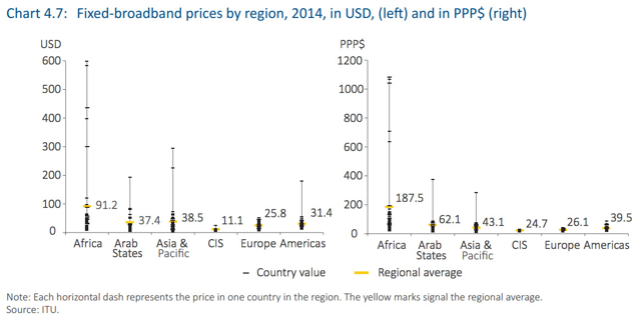In this blog posts on information technology and humanitarian development have thus far focussed on the potential that is offered in tackling specific development problems. Lower levels of connectivity restrict the overall impact that higher levels of connectivity can have. That is the emphasis of this post – the potential for integrated, connectivity based development.
Global Poverty
Global poverty remains a serious issue, although some progress has been made in recent years. According to the World Bank, in 2013 10.7 % of the worlds population lives on less than $1.90 per day which is down 35 % since 1990. The problem is still very serious though – 10.7 % is 767 million people, who live extremely difficult lives.
Improvements which have happened have largely been in East Asia and the Pacific Region. Progress has been especially notable in India. Half of the world’s poorest people live in Sub Saharan Africa, where 389 million people live on less than $1.90 per day.
Efforts continue to alleviate world poverty and create sustainable economic development to improve the incomes and lives of poorer people. Information technology may have a substantial role to play here.
Can Information Technology Enable Economic Development?
Earlier posts in this blog have referred to examples of the use of information technology to improve peoples’ lives in developing countries. These examples span a number of areas, including agriculture, health, education, fishing, banking and the functioning of government. They show that substantial benefits are possible if information technology is appropriately used.
Use of information technology in humanitarian development also has significant benefits. Its use in supporting the work of Non-governmental organisations in their activities to create sustainable development and provide famine and disaster relief as well as in their work with refugees is supported by NetHope who the University of Waterloo has worked with for the past ten years:
University of Waterloo Support for the Use of Technology in Development
Over the past ten years Masters students from the University of Waterloo have worked on over 25 projects to support the use of information technology in the work of humanitarian development organisations. These projects have included research on technologies to improve the accessibility of electrical power, to increase connectivity and in the work of the NGO’s themselves through examining their social media and project management practices. The projects have also looked at the use of information technology in agriculture, health and education and at technologically based solutions for the counterfeit drug problem. The role of information technology with refugees and its potential in encouraging entrepreneurs has also featured in the projects.
These projects have sought to encourage the appropriate use of information technology in humanitarian development and provide further examples of how information technology can be effectively applied. The overall impact that technology will have will partly depend on the future development of connectivity – the access that those in developing countries have to the internet.
Connectivity Today
The oAfrica website provides links to data on the levels of connectivity in Africa today. It is important to note that the digital divide, the divide between those with internet access and those without, also discussed elsewhere on this blog, exists in many parts of the world. The World Wide Web Foundation provides data on a wide range of indicators of the impact of the internet. The International Telecommunications Union provides extensive connectivity statistics that enable better understanding of the detail of the digital divide.
These statistics illustrate the digital divide on an international basis:
The chart above shows levels of internet accessibility globally. It is based on household internet access and does not include mobile access, which will be discussed later in this post. The next chart shows the price of internet access and illustrates one of the main challenges in expanding internet access in developing countries:
This chart shows that the cost of household internet access in developing countries is far higher than that in developed nations. there are many reasons for this which include the low density of the population, with many living in rural areas with no telecommunications or electricity infrastructure.
Mobile is often argued to be a solution to this problem and in many developing countries mobile internet access is increasing rapidly, providing access to many new services and supporting some development. This remains restricted though by data costs which tend to be relatively high.
Efforts to expand lower cost internet services have been taking place – Facebook and Google been especially active here.
Facebook Free Basics and Google Project Link
Efforts to expand internet connectivity in developing countries have been pursued by local companies and organisations, by NGO’s and others. These efforts are driven by an understanding of the potential economic and social benefits and also by the commercial opportunities that increased connectivity creates. Facebook and Google have been especially active in this area and their work has sparked controversy.
Facebook’s Free Basics service provides free data access to selected internet sites which include local news and jobs, sports scores and, of course, Facebook itself. Access to other internet sites is possible, through the payment of additional fees. Facebook argue that their services allow people in developing countries to access the internet who would otherwise not be able to do that. However, they have been criticised for controlling the sites that users have access to and the potential misuse of this that may occur. India has stopped Facebook offering Free Basics there and the arguments in the debate on this are articulated in the following video:
Google have also had their own efforts to increase connectivity, known as Project Link, which is designed to provide local connectivity in countries where this doesn’t exist. Their work on this has so far focussed on Uganda and Ghana and has provided high speed home internet service in metropolitan areas. Google’s efforts have been less controversial as they have not limited access to specific sites.
Other efforts are underway to expand internet access. Facebook are looking at the use of solar powered drones to provide Wifi access, OneWeb from Virgin are looking at the use of satellites while Google’s Loon is considering high altitude balloons.
These developments are intended to expand the commercial opportunities that exist for the companies that provide them. Expanding internet access expands the market for advertising and other services that they offer. The access that is provided can also support efforts for economic and social development, based on the possibilities that would exist for this in a fully connected world.
Integrated Development
The work that has been undertaken at the University of Waterloo on information technology and development has included consideration of the impact that a fully connected world would have. There would be many areas that might benefit, including the areas that were outlined earlier in this post. In agriculture, health and education more connectivity would enable more to be done.
The collective impact of connectivity is also important. One of the areas that this was examined in was that of entrepreneurs. Higher levels of connectivity would provide many benefits for them, including better access to markets, education and training, connections with investors (both locally and internationally) and the potential for collaboration with business partners. This area illustrates the integrated value that widespread connectivity can have on development. As connectivity improves, new possibilities for development will also emerge.
Conclusion
This post has provided a discussion on the impact of the expansion of connectivity in developing countries today. posts in this blog have previously emphasised the individual areas in which connectivity can provide benefits. This post initiates discussion on the integrated possibilities when higher levels of connectivity are achieved.


